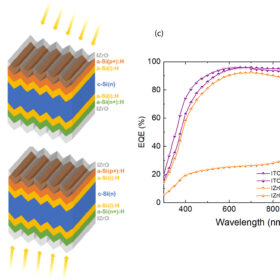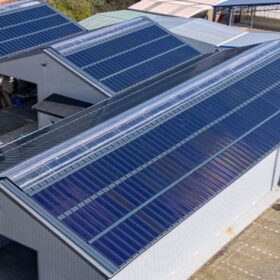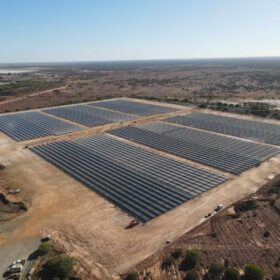Soltec launches specially designed floating PV tracker
Soltec has developed a floating PV tracker with pumps in the central tank for mobility and ballast, enabling operation in wind gusts above 100 km/h.
Zirconium-doped indium oxide electrodes for heterojunction solar cells
A research team including scientists from Italian module manufacturer 3Sun has tested new zirconium-doped indium oxide electrodes in commercial heterojunction solar modules. The new electrodes reportedly achieve the same performance as their counterparts based on indium tin oxide and paves the way for lower indium consumption in heterojunction products.
JinkoSolar hits highest conversion efficiency with 182 mm TOPCon module
JinkoSolar says its 182 mm tunnel oxide passivated contact (TOPCon) solar module has achieved a conversion efficiency of 25.42%.
Rectangular wing vortex generators for solar module cooling
University of New South Wales researchers have created vortex generators that can reportedly reduce the operating solar module temperature by up to 2.5 C. They built two different prototypes, based on aluminum and a conductive 3D printable polymer, and tested them under several scenarios in an experimental setting deployed in Sydney.
Heliatek develops lightweight organic PV module for low load-bearing roofs, facades
German organic PV manufacturer Heliatek has announced a new series of lightweight modules. The Heliasol 436-2000-CFE-45-600V panels are IEC 61215 and IEC 61730 certified and have a 20-year lifetime warranty.
Modular solar solution helps mining operation shift to renewables
Modular solar specialist 5B’s pre-assembled and relocatable Maverick solar solution has been unfolded in another off-grid hybrid renewable energy project as the decarbonisation of Australia’s mining sector continues.
Home office, schooling helped distributed PV address duck curve challenge during Covid-19 crisis
New research from the United Kingdom shows how during the Covid-19 crisis homeowners relying on PV and storage were able to considerably reduce grid electricity reliance, while increasing self-consumption rates. The analysis included 100 houses equipped with solar arrays ranging in output from 1.71 kW to 4.86 kW and batteries ranging from 2.5 kW to 3.3 kW.
Optimized antimony trisulfide solar cells may reach 11.68% efficiency
An international research group has analyzed the most important barriers preventing antimony trisulfide solar cells from reaching satifsfying power conversion efficiencies and has suggested a series of optimization parameters that could get them closer to commercial production.
West Virginia researchers to deploy agrivoltaics on small cattle farms
Researchers from West Virginia University have secured $1.6 million from the US Department of Energy to install and assess the benefits of agrivoltaics on small cattle farms.
BASF, NGK launch sodium-sulfur battery with less than 1% degradation rate
A set of technological improvements incorporated into the new product NAS MODEL L24 allows for lower maintenance costs compared to the earlier sodium sulfur battery type developed by the two manufacturers.










